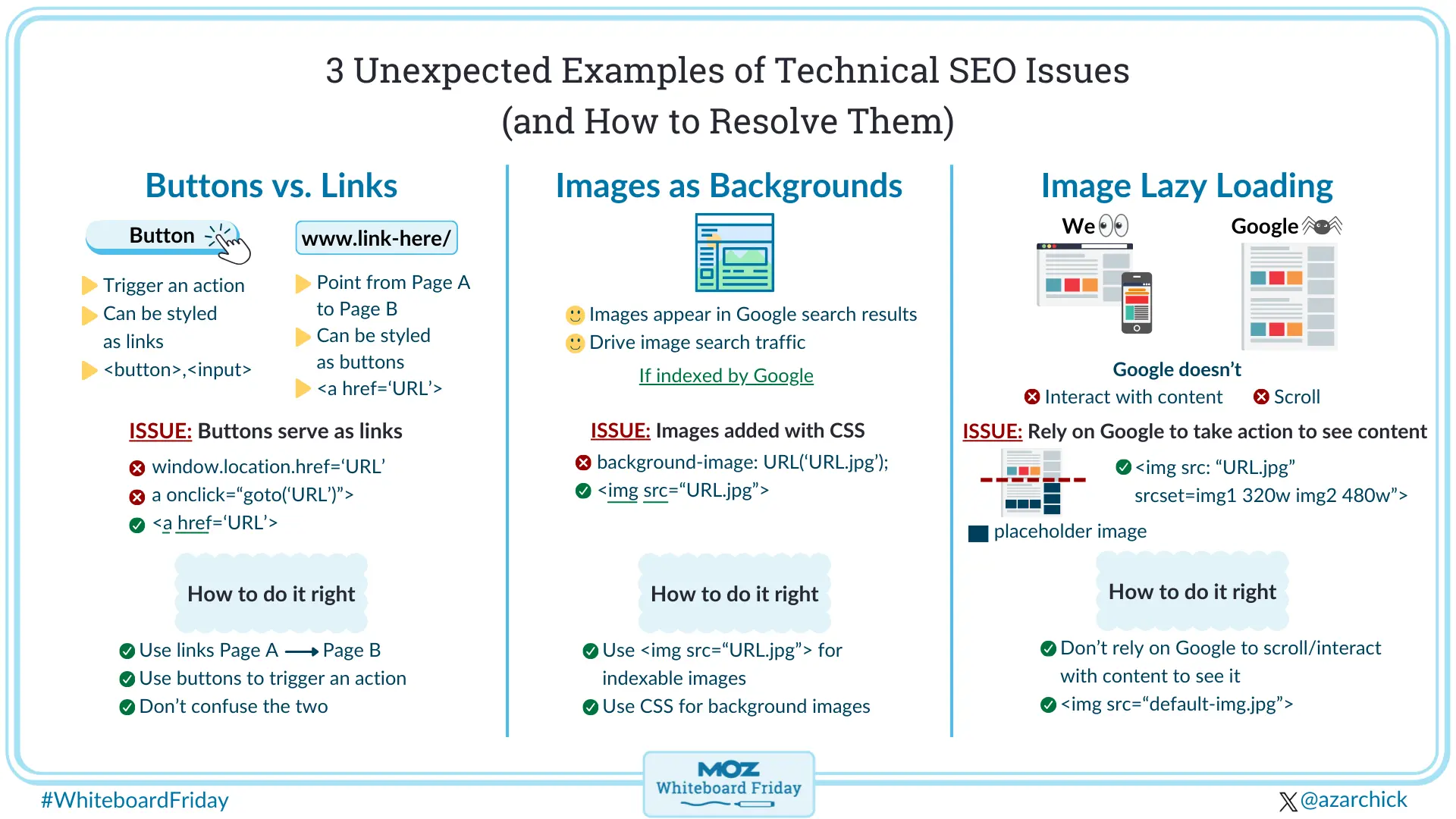Outrank Competitors With Content Gap Analysis
3 Types of Content Gap Analysis to Outrank Your Competitors
The author's views are entirely their own (excluding the unlikely event of hypnosis) and may not always reflect the views of Moz.
Many content marketers find themselves in a creative rut when brainstorming fresh content ideas.
Even after exhaustive keyword research and brainstorming sessions, the struggle to address customers' pain points with relevant blog topics persists. While most content marketers resort to scouring social media profiles, others experiment with different keywords with no success.
To break out of this rut, content marketers can explore various content creation strategies, and one effective strategy is the content gap analysis. Done right, a content gap analysis can help you find high-quality content ideas, monitor your competitors, and beat their SERP rankings.
But let’s circle back for a moment and start from the beginning. What does a content gap analysis entail? How can content marketers use this to uncover winning topics? Here’s a closer look.
What is a content gap analysis?
A content gap analysis is the process of reviewing the current state of your competitor’s content to identify weak points (or gaps) in your existing content. In a presentation delivered by Chima Mmeje, founder of Zenith Copy, she explained, "It’s about finding holes in your content, specifically missing content that should help the buyer on their journey.”
In essence, a content gap analysis extends beyond identifying high-volume keywords. It’s about finding relevant content to strengthen your marketing funnel and guide customers across multiple touchpoints. This analysis exposes potential vulnerabilities in your content pipeline where it falls short in addressing customer needs.
What are the three types of content gap analysis?
There are three main types of content gap analysis:
-
Competitor-based content gap analysis,
-
Topic-based content gap analysis, and
-
Buyer-based content gap analysis.
Each type brings a unique perspective to enhance your content. Combine all three, and you will exploit loopholes to generate content ideas beyond obvious keywords. Let’s discuss each in detail.
Competitor-based gap analysis: Content gap analysis between your and your competitor's keyword
The first content gap analysis method is a competitor-based gap analysis. As the name implies, it involves analyzing your competitor’s website to understand their target market, content strategy, keyword choices, and product use cases to find what’s working for them.
While it can be time-consuming — especially in competitive niches — the insights gained are well worth the effort. Here's how to go about a competitor-based gap analysis.
How to conduct a competitor-based content gap analysis
There are five steps to doing a competitor-based content gap analysis:
Step 1: Find 5 — 10 competitors in your niche
Before gathering any keywords, you should identify 5 — 10 significant competitors in your niche. Identifying direct competitors is easy; you can do a quick Google search or ask the sales representatives for companies mentioned by potential customers during sales calls.
Alternatively, you can find your direct competitors with Moz’s True Competitor tool. Input your domain or subdomain to generate a list of your top 25 competitors vying for the same keywords.
Step 2: Create a list of market-relevant and trending keywords
Once you’ve identified 5 — 10 organic competitors, the next step is to scrape keywords from their websites. Your objectives are to:
-
Identify the keywords that give your competitors an edge in search rankings.
-
Find untapped keywords from both your competitors and your content.
-
Compile a keyword list to help your page get to the top of the search results.
You can use Moz’s Keyword Explorer tool to extract keywords from your competitors. Just enter your website’s URL, along with two competitors, and the tool will gather each website’s top-ranking keywords. The great thing about Moz’s tool is that you can see the keyword overlap between all competitors and identify which ones might be best to work on.
You can export this information as a CSV, including both the Difficulty and Search Volume relating to each keyword.
You can also look at the search results for your target keywords, which may show multiple competitor pages, especially if your competitors are larger companies that invest heavily in content production. Don't feel overwhelmed by the sheer number of keywords or pages ranking for your target keywords. It’s important to prioritize, which you can do by looking at the keyword metrics for keywords via your exported CSV.
Step 3: Segment your keywords (topics) into groups to find opportunities
After exporting your keywords, the next step is to group similar keywords by parent topic to find unexplored opportunities. This process provides clarity and allows you to eliminate irrelevant keywords.
You can do this manually with your exported CSV file, or use Moz’s Keyword Research tool.
Manually pair complementary keywords in your spreadsheet to create a hierarchy of keyword groups and subgroups and build topical authority. Here’s an example of a cluster:
Because they share semantic relevance, topics with the keyword “b2b content strategy” are clustered together. As you cluster your keywords, be sure to prioritize:
-
Keywords that are relevant to your audience
-
Keywords with lower-to-medium volume (long-tail keywords)
-
Keywords that enable you to showcase unique product use cases.
-
Valuable keywords that are driving a ton of traffic and backlinks to your competitors
-
Keywords with high-purchase intent
Alternatively, you can use Moz Pro to group your keywords together. The Keyword Suggestions section allows you to group keywords by lexical similarity, as well as what type of keyword it is, e.g., a question.
Step 4: Identify content overlaps & remove duplicate keywords
Having duplicate content and keywords is terrible for SEO because it impacts search engine rankings. So, after grouping keywords, delete keyword duplicates and content overlaps. Examples of duplicates are synonymous keywords that mean almost the same thing, e.g., SEO copywriter for SaaS and SaaS SEO Copywriter.
Step 5: Create a new content plan or align your existing strategy
With your keyword cluster, create a content plan. A good content plan creates a structured order for researching, writing, and distributing content.
More importantly, it helps you understand the types of content your audience finds engaging and determines the best way to publish it. A content plan could be an editorial calendar or a roadmap to show the content type you’ll be creating for your readers and the methods of distribution for that content.
Isaac Hammelburger, Founder of Search Pros, shared an interesting case study on performing a competitor-based gap analysis:
“I worked for a relatively new client in the commercial insurance space with very little existing content. To tackle this, I ran a content gap analysis by examining major websites in the space, including Hiscox, Insureon, and The Hartford, to help determine what content we need to build.
I extracted keyword data from each site and organized it in a Google Sheet, creating a matrix of keywords, search volumes, and their respective rankings on the three websites.
I categorized the content into "Insurance types," "industries," and "locations." Subsequently, I embarked on creating a content library that addressed each of these categories. Fast forward 18 months, and our traffic had surged to over 10k monthly visitors.”
Topic-based gap analysis: Content gap analysis between your on-page and competing on-page content
Imagine you're tasked with writing about a topic already covered by many competitors. How do you create valuable content without being a copycat?
As a writer, this is a common challenge with every new brief. It wasn't until I analyzed the existing content landscape that I discovered a solution: addressing unsolved pain points with a unique perspective. This could mean redefining the problem, incorporating more data, or introducing new case studies.
So, how do you conduct a content gap analysis between your page and your competitors'?
How to do a topic-based content gap analysis
There are five steps to doing a topic-based content gap analysis. Let’s take a look at each one in detail.
Step 1: Start with a real-time analysis of the first ten results on Google.
The first step to rank your content on Google for a target keyword is reviewing the top ten articles ranking on Google. According to Ben Goodey, this serves two purposes:
-
Understand what’s currently ranking and determine what sections to include (or omit) in your content.
-
Establish a basic understanding of the topic.
Chima Mmeje, in an interview with WTS, also emphasized the significance of SERP analysis, saying, “My favorite task is doing SERP analysis. I love reviewing the top 10 content pieces ranking for a keyword and tearing them apart to understand why they rank and find content gaps I can explore.”
Like Chima, SERP analysis is my first line of action when tackling a new brief. This analysis gives me insight into details such as:
-
Depth: Does the content extensively cover all relevant points on the topic? Is the content thorough, and does it explore all angles?
-
Keywords: What keywords are competing articles targeting within their content? Does the content match the intent behind the targeted keyword?
-
Content format: Are the top results for a keyword videos, articles, infographics, or other content formats?
-
Freshness: Find out the last time the article was updated and if the information needs to be updated and needs new data.
-
Readability: Is the content well-structured, readable, and logical? Is it easy to navigate and interact with?
-
Backlink opportunities: Find backlinks from competing articles and discover potential link-building opportunities.
Tools like Moz Pro are great for conducting a SERP analysis, but that's the starting point. Nothing beats an in-depth, solid research process to uncover unexploited ideas and create original pieces.
Step 2: Decide on a unique angle to approach the content.
Once you’ve analyzed the SERP results, the next step is finding a unique keyword approach. Is there something fresh to add to the topic? Maybe a new case study, or have you uncovered a key reason why readers still face this issue?
You need a differentiating factor that sets your article apart from the competition, which could be:
-
Addressing an unresolved pain point.
-
Going in-depth with actionable screenshots, images, or videos.
-
Incorporating more relatable case studies and examples.
Step 3: Create a content brief
Content briefs are created to establish a clear direction on what’s expected in a piece. A detailed brief aligns you and your writer on its intended style and outcomes to avoid the need for extensive edits and revisions.
I spoke with Precious Oboidhe, and he noted, “A good brief should share the vision of what's expected from a piece. When I get a brief, I look out for the article's goal, SEO information, and details about where the audience is and where we expect them to be after they finish reading the piece.”
Creating a thorough SEO content brief may seem easy, but it can be complex. Check out valuable resources from Moz for guidance on crafting SEO-focused content briefs.
Step 4: Optimize your content for SEO
Once your article is finished, optimize it for SEO. If you use content optimization tools like Clearscope, aim for a high SEO score to create Google-friendly content. Here’s how:
A. Optimize your title to align with the topic’s main idea.
B. Ensure your targeted keywords match the search intent.
C. Organize the content structure logically, with relevant H2 and H3 headings answering questions.
D. Add internal links for better navigation and search bot crawling.
E. Optimize content depth to go beyond competitors without deviating from the main point.
F. Craft an engaging and search-optimized meta description.
G. Optimize sections for featured snippets.
Victoria Kurichenko, an SEO expert and writer, shared an interesting case study on topic-based content gap analysis. After noticing a drop in high-ranking content on her Beehiiv article, she conducted a content gap analysis by collecting keywords the competitor's content ranks for. Then, she rewrote and optimized her article, meta title, and description.
The results:
-
Impressions tripled.
-
Daily clicks increased from 2–5 to 20–30.
-
The article secured a top 5 ranking for target keywords.
-
The article started ranking for new keywords. She even got two new referrals within two weeks after the content update.
Buyer-based gap analysis: Content gap analysis in the buyer's journey
A buyer-based gap analysis focuses on understanding the difference between what customers expect and what a company delivers. It does this by evaluating content at various stages of the buyer’s journey to align the company’s marketing and sales strategies with the evolving needs of its target audience. Addressing gaps in your buyer’s journey helps buyers transition smoothly between stages.
How to do a buyer-based content gap analysis
There are five steps to doing a market-based content gap analysis:
Step 1: Map out the buyer’s journey
The first step in a buyer-based gap analysis is mapping the buyer’s journey. Put simply, a buyer’s journey is a representation that outlines a potential customer's process before purchasing. This happens in four stages:
A. Awareness stage: This buyer recognizes a problem.
B. Consideration stage: This buyer delves deep into the problem and seeks solutions.
C. Decision stage: This buyer selects a product to resolve the issue.
D. Post-purchase: After buying, the customer starts using the product
Mapping a buyer’s journey means understanding their process and expectations at each stage. This insight helps anticipate their touchpoints and tailor strategies to meet their needs. For example, let’s map the buyer’s journey for a social media management tool:
-
Awareness stage: Prospect realizes their struggle to grow their social media and begins searching for a solution. Common touchpoints at this stage are online searches, social media, company blogs, and word of mouth.
-
Consideration stage: Prospect actively looks for solutions and compares different tools. They might read comparison posts, check out product demos (and free trials), and even read case studies.
-
Decision stage: Prospect is ready to decide and upgrade to a paid plan. They have questions about the pricing plan, customer support, and product value.
-
Post-purchase: This involves product onboarding to help customers start and maximize product value. Common touchpoints are in-app resources, communities, and customer support.
Step 2: Identify Personas and their pain points at each stage
Once you’ve mapped your buyer’s journey, the next step is creating personas. Put simply, a persona is a fictional character representing your ideal customers. Different personas may have different needs and questions at each journey stage, which, if left unanswered, can lead to confusion and customer churn.
In the social media management tool example above, your personas could be a social media manager, a small business owner, or a freelancer. To gain insights into their thoughts, consider these methods:
-
Collect customer feedback through surveys, interviews, or feedback forms.
-
Analyze customer support tickets for recurring issues. Consult your support team for common concerns and challenges.
-
Monitor social media conversations for discussions, complaints, and questions.
-
Review website analytics for drop-offs, high bounce rates, and low engagements.
-
Use keyword research tools to identify search terms customers use when looking for a solution related to your product.
With this data, you’ll gain firsthand insights into the customer pain points to create marketing materials to address them effectively.
Step 3: Create a content inventory of existing content
Take inventory of every piece of content on your website to get a full scope of your website’s assets. Your list should include existing content, including landing pages, articles, videos, images, PDFs, guides, and in-app resources.
Audit this content and assign it to one of the three groups:
A. Keep: Retain content that drives traffic and backlinks.
B. Merge: Combines duplicate content targeting similar keywords into a more in-depth article.
C. Trash: Delete content targeting the wrong keywords, underperforming or outdated.
Compile this list and map each content piece with relevant buyer stage(s) and persona. This visual mapping clarifies your content alignment and highlights whether your efforts are sufficient.
Step 4: Identify the content gap for each buyer’s stage.
Once you’ve categorized your content for each stage of the buyer's journey, identify the current gaps in your content pipeline. Analyze your competitor’s content strategies, particularly successful ones, to assess how well they address customer pain points at each stage and what content types they utilize.
A good starting point is examining your competitor’s blog and paying attention to the user intent and keywords they’re targeting. Rejoice Oji explains how to map keywords to the buyer’s journey and user intent in her Whiteboard Friday with Moz.
Find content ideas to satisfy the keywords for each stage. Here are a few ideas:
-
Write optimized blog posts targeting keywords that address customer pain points.
-
Create product videos to explain new features on social media.
-
Host webinars and repurpose the content into blogs, videos, or infographics for social media.
-
Use email newsletters to engage leads, promote exclusive offers, and share customer stories.
-
Create freebies like templates and checklists to attract potential customers.
Step 5: Create a content plan for each stage and identify short-term and long-term gaps to fill
The final step is to create a buyer’s journey-specific content strategy. That means developing a personalized content strategy for each audience segment instead of a generic content strategy. Determine the content type that will address short-term and long-term content gaps. Then, you can conduct keyword research to create new content or update existing pieces.
Antonio Gabric, shared an interesting case study:
“At the Hunter blog, we cover all things related to cold email, lead generation, and outbound marketing in general. We managed to attract a lot of organic traffic to our blog but failed to generate revenue.
That's when we decided to analyze what our competitors are doing differently than us. We soon identified that we were missing listicle content (BoFU), which provides an overview of the top tools relevant to cold email. With a quick analysis, we identified 15 relevant keywords to our business that have huge revenue potential.
We pursued those keywords, even though the competition is fierce. Through building topical authority, creating strategic topical clusters, and acquiring authority backlinks, we achieved a goal—gen
Final thoughts
Conducting a content gap analysis can help you identify opportunities to outrank competitors. You can spend hours on extensive keyword research, but it makes sense to look at what’s working for your competition and then do better. If you’re considering conducting a content gap analysis, use one of the three discussed in this article to uncover areas where your content is lacking and make strategic improvements.







